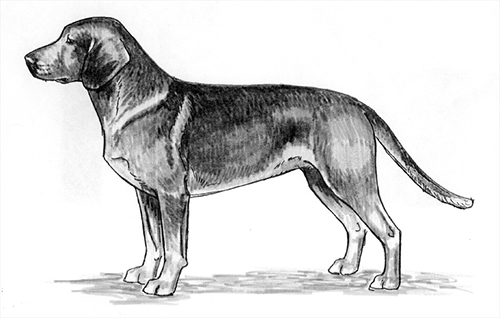Alpine Drachsbracke
Scenthound Group
The goals and purposes of this breed standard include: to furnish guidelines for breeders who wish to maintain the quality of their breed and to improve it; to advance this breed to a state of similarity throughout the world; and to act as a guide for judges.
Breeders and judges have the responsibility to avoid any conditions or exaggerations that are detrimental to the health, welfare, essence and soundness of this breed, and must take the responsibility to see that these are not perpetuated.
Any departure from the following should be considered a fault, and the seriousness with which the fault should be regarded should be in exact proportion to its degree and its effect upon the health and welfare of the dog and on the dog’s ability to perform its traditional work.
History
In the late 19th Century, the gamekeepers for Crown Prince Rudolf were using a hunting/shooting dog that bore a strong resemblance to the modern Alpine Drachsbracke. The breed was used as a tracking dog for wounded deer and a scenthound for hare and fox. In 1932 the breed was recognized in Austria, and in 1991 it was accepted as a Scenthound by FCI.
The Alpine Drachsbracke was recognized by the United Kennel Club January 1, 1996.
General Appearance
The Alpine Drachsbracke is a rectangular shaped, short legged, sturdy hunting dog with robust, strong boned body structure, a dense coat and firm muscles.
Characteristics
The breed has a fearless personality.
Head
SKULL
The skull is slightly arched. There is a well pronounced furrow between the eyes. The occiput is barely prominent. The stop is distinct.
MUZZLE
The muzzle is strong and slightly shorter than the skull. The lips are close fitting, moderately rounded and have black pigment.
TEETH
The Alpine Drachsbracke has a complete set of evenly spaced, white teeth meeting in a scissors or level bite. The absence of the first or second premolars is tolerated.
NOSE
Black.
EYES
Dark brown in color, with close fitting, black rims.
EARS
Set on high, without folds, hanging close to the cheeks, well rounded at the tips, the ears should reach nearly to the end of the muzzle.
Neck
Muscular, and not too long.
Forequarters
The shoulder blades are close-fitting, long, sloping, and strongly muscled.
FORELEGS
The front legs are straight and strong. They appear short in relation to the length of the body.
Body
The trunk is strong and well muscled, and elongated, in a ratio of length to height of 3:2. The chest is deep and broad, and there is a pronounced forechest. The depth of chest should be about one half the height at the withers. The back is straight, and the loin is short and broad. The croup is barely sloping. The belly is moderately tucked up.
Hindquarters
The hindquarters are muscular, strong, and well-angulated.
HIND LEGS
Seen from the rear, the hind legs are straight.
Feet
Round, with tight toes, strong pads and black nails.
Tail
Set on high, strong at the root, reaching barely to the ground in length, and carried somewhat low. There is a brush of hair on the underside of the tail.
Coat
A thick, dense close fitting, double coat.
Color
The preferred color is dark deer red, with or without interspersed black hairs. Also acceptable is black with clearly defined rust red markings on the head, chest, legs, feet and underside of tail. A white star on the chest is permitted.
Height and Weight
Ideal height for males is 15 inches. For females it is 14 inches.
Gait
Movement is ground covering.
Eliminating Faults
(An Eliminating Fault is a Fault serious enough that it eliminates the dog from obtaining any awards in a conformation event.)
Height less than 13 inches or greater than 16.5 inches.
Disqualifications
(A dog with a Disqualification must not be considered for placement in a conformation event, and must be reported to UKC.)
Unilateral or bilateral cryptorchid.
Viciousness or extreme shyness.
Albinism.

Looking for a Dog?
Find a dog that will fit your family.
Note: The breeders on this list are not endorsed by UKC.
Revised July 1, 2009
©Copyright 1996, United Kennel Club
